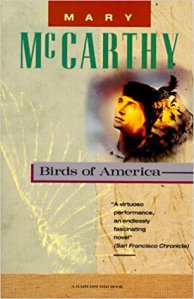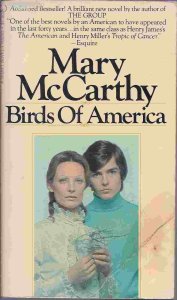 Mary McCarthy’s 1971 satire, Birds of America, is a tour de force. Set in New England, Paris, and Rome in the 1960s, it skewers both American innocence and hypocrisy.
Mary McCarthy’s 1971 satire, Birds of America, is a tour de force. Set in New England, Paris, and Rome in the 1960s, it skewers both American innocence and hypocrisy.
I chortled over this comic novel, which is still pertinent today, but, bizarrely, it seems little-known. You don’t have to know about the 1960s to be amused by her mockery of frozen foods, a pious Thanksgiving abroad (which the hero calls “a harvest fest”), the faux-historicism of New England villages, and tourism in Europe (the protagonist thinks tourists should be licensed to go to art museums).
 The 19-year-old hero, Peter Levi, an amateur ornithologist, is the son of the twice-divorced Rosamund, a harpsichordist with old-fashioned WASP values, and his father, “Babbo,” a Jewish-Italian art historian who teaches at Wellesley. Peter’s bird-watching is the ideal training for observing his elders and criticizing society, though his point of view is very odd.
The 19-year-old hero, Peter Levi, an amateur ornithologist, is the son of the twice-divorced Rosamund, a harpsichordist with old-fashioned WASP values, and his father, “Babbo,” a Jewish-Italian art historian who teaches at Wellesley. Peter’s bird-watching is the ideal training for observing his elders and criticizing society, though his point of view is very odd.
McCarthy can eviscerate with a few well-chosen images. Take the scarcity of bean pots. In Rocky Port, a small New England town where Rosamund and Peter live for a short time after she leaves her second husband, Rosamund has decided to cook only American dishes from an old Fannie Farmer cookbook. But she cannot find a bean pot at the grocery store.
“How extraordinary, Peter! The man says they don’t make them any more. Do you think that can be true?” She was always asking him wide-eyed, troubled questions like that one, to which he could not possibly, at his age, know the answer; it was a kind of flattery, applied to the male ego. The only bean pot Peter was familiar with was pictured on a can. But the saw that for his mother this was a truly upsetting discovery, tantamount to finding that the American eagle was extinct. She was even more ruffled when she returned from her weekly shopping trip with the report that the two hardware stores in the neighboring town did not carry bean pots either.
Now Rosamund is my favorite character in the book, but I also see Peter’s point of view: why not just use a casserole? And after she searches hardware stores in neighboring towns and comes up with nada, their landlady gives her a bean pot she had used as vase for dried grasses. And that is the fate of bean pots and other old things: they are used decoratively, or stuck in the attic.
 In college, Peter becomes a radical, but his parents won’t allow him to go to Mississippi with a Students for Civil Rights group. Ironically, during a summer vacation in Rocky Port, Rosamund and Peter are arrested when Rosamund refuses to put up a fake historical sign on the rented house (long story!) for a parade and festival for tourists.
In college, Peter becomes a radical, but his parents won’t allow him to go to Mississippi with a Students for Civil Rights group. Ironically, during a summer vacation in Rocky Port, Rosamund and Peter are arrested when Rosamund refuses to put up a fake historical sign on the rented house (long story!) for a parade and festival for tourists.
Most of the book takes place during Peter’s junior year abroad in Paris, and it is very funny indeed. Peter is genuinely concerned about politics, but he doesn’t quite get the protocol of French student protests, where there is a tacit agreement between police and students that those arrested will be let go in a few hours. His attempt to intercede in an arrest annoys one of his acquaintances, but Peter’s complaint at the embassy is so ridiculous that he does eventually get them to make inquiries: of course the boy had been let go almost immediately!
Peter and his fellow American students, annoyed by the dumbed-down American program at the Sorbonne, have little practice speaking French, because the French ignore them. His most satisfying interactions are with a French bird-watching group.
So how does Peter spend his time? He argues about politics. He travels to Rome. He spends a lot of time furtively scrubbing the shared toilets in French and Italian hotels (in Rome a group of German tourists dominate the toilet all morning). And, not surprisingly, a quixotic attempt in Paris to help a homeless drunkard by letting her stay on his couch ends in disaster. (She vomits on the couch and steals his doorknob.)
I thoroughly enjoyed Birds of America, which was published in 1971. And I hope McCarthy is having a comeback: the Library of America just published her complete fiction. My own favorite McCarthy novel is A Charmed Life, a satire of an artists’ colony in a New England village. You can read my post here. But I have read several of her books, and enjoyed them all.


As someone else who didn’t get that tacit agreement between French students and police (there was nothing like it in England, let me tell you) I really should read this. Like most British teenager girls of the 60s I read McCarthy’s novel The Group, but I’m ashamed to say I’ve read nothing else. I hope I’m going to be able to find a copy of this in the UK.
LikeLike
No, in the U.S. protests didn’t work like that either! I very much enjoy The Group, but I do prefer her satires, especially A Charmed Life and The Groves of Academe.
LikeLike
Given your comment and the one below plus my own goodness knows how many years in academia I am absolutely going to have to read The Groves of Academe!
LikeLike
It’s very, very funny, as good as or even better than Lucky Jim and other academic satires!
On Sun, Sep 17, 2017 at 10:02 AM, mirabile dictu wrote:
>
LikeLike
I have enjoyed several of Mary McCarthy’s books, including Memories of a Catholic Girlhood. I may not have the title quite right. Some said that many of her memories were fictional but that is understandable — she was a fiction writer. Did she not write The Groves of Academe? It was a very funny send up of the pretensions of an academic community.
LikeLike
Oh, I did read and love Memories of a Catholic girlhood! She is a great writer, neglected, except for The Group, because of her satiric tone, I wonder?
LikeLike
Shamefully, I have at least two (possibly three) McCarthy books lurking, none of which I’ve read. Time to pull them out and try to read them, because there’s really no good reason why I haven’t.
LikeLike
I do love her books and hope they’re coming back into fashion.
On Sun, Sep 17, 2017 at 10:22 AM, mirabile dictu wrote:
>
LikeLiked by 1 person
The only McCarthy book on my shelves is Venice Observed (non-fiction) and on the tbr list. She did seem to fall into obscurity in recent decades.
LikeLike
I do know this and her book on Florence are admired but have not read them.
Sent from my iPad
>
LikeLike
Randall Jarrell’s Pictures from an Institution contains an entertaining satirical portrait of McCarthy herself.
What’s the difference between a bean pot and a casserole anyway?
LikeLike
I must read the Jarrell, which we have in a box somewhere. We use a casserole. My mother liked frozen foods & made a casserole of baked beans with hot dogs! She was a modern housewife of the ’60s.
Sent from my iPad
>
LikeLike
Pingback: Reading from the Shelves: Thanksgiving Reading Plans – mirabile dictu
Pingback: My Favorite Books of 2017 – mirabile dictu
Pingback: A Mary McCarthy Revival and The Oasis – mirabile dictu